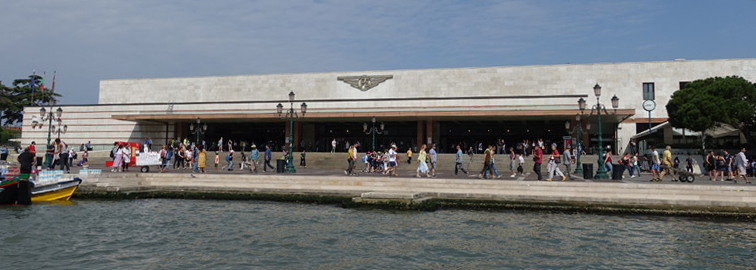italy-2019-17
June 19, 2019
italy – 2019
sixteenth-post – venice
click to read all the italy – 2019 posts
efficiency
The Venice train-station deserves its own post.

This brief history of the train-station if from Wikipedia. – The current station building is one of the few modernist buildings facing the Grand Canal. It is the result of a series of plans started up by the rationalist architect Angiolo Mazzoni in 1924 and developed by him over the next decade.
In 1934, a contest for a detailed design for the current station was won by Virgilio Vallot. Between 1936 and 1943, Mazzoni and Vallot collaborated on the construction of the station building; Mazzoni also designed the train hall. The final implementation, however, was undertaken only after the Second World War. In 1952, the station was completed on a design which had been developed by another architect, Paul Perilli.
In November 2009, work began on the renovation of Santa Lucia station. The renovation would include improvements to the use of spaces and the flow of internal transit. In addition, certain architectural elements would be recovered and restored; the atrium would be altered to house several retail spaces. This project was completed in 2012 with a cost of 24 million euros.
Throughout Italy, train-stations tend to be in the older, poorer sections of town; well not in Venice. Throughout Italy, train-stations are riddled with graffiti and garbage; not in Venice. Throughout Italy, train-stations are areas that attract pickpockets, migrants and the homeless; not so in Venice. Throughout Italy, train-stations are cruising areas, pick-up spots and venues for beggars; not in Venice. Throughout Italy, the old, 19-century train-stations are being torn down and replaced by soul-less concrete coverings; the Venetians renovated their pre-war station for modern times. The Santa Lucia train-station is elegant, clean and well run; it has cafes and small restaurants that are efficient and reasonably priced. And Venice is on the newly built, high-speed – Frecciarossa – train system. (I decided that I wanted to travel at bullet-speed and in comfort, so I bought tickets in the QUIET/Business carriage of the Frecciarossa; we enjoyed our 4-hour ride to Rome.)
Using our 24-hour pass, we boarded the #1 vaporetto to Santa Lucia at 8:11 and by 10:30 we were speeding towards Baroque Rome. We made 3 stops – Padova, Bologna and Florence. Only the Bologna station was as clean and as graffiti free as the Venice terminal; the rest fit the stereotype. The Florence train-station was particularly dirty, graffiti strewn and surrounded by dilapidated buildings.